Agricultural Tractor Roll-Over Related Fatalities in Italy: Results from a 12 Years Analysis
Abstract
1. Introduction
1.1. Type of Overturning
1.2. Drivers and Job Characteristics
1.3. Problems with Accident Statistics
1.4. Situation in Italy
2. Materials and Methods
2.1. Strengths of the Study
- -
- maximum timeliness in the monitoring of the accidents;
- -
- a reduced commitment of resources;
- -
- an acceptable approximation.
2.2. Limitations of the Study
- -
- the obtained statistics show values that could not completely reflect reality. For example, some fatal events could be missed, because the tractor overturning causes at a first step serious injuries to the driver, and only after a period of time, the involved person dies, but the news is no longer reported;
- -
- it cannot be systematic, as the details level of the reported events should be not completely congruent. For example, the working position of the victims (professional or non-professionals) is not usually reported;
- -
- it may sometimes suffer from the press inaccuracies.
3. Results and Discussion
3.1. Results
3.2. Discussion
4. Conclusions
Author Contributions
Funding
Institutional Review Board Statement
Informed Consent Statement
Data Availability Statement
Conflicts of Interest
References
- INAIL. Banca Dati Statistica. Available online: https://bancadaticsa.inail.it/bancadaticsa/login.asp (accessed on 8 April 2021).
- Dogan, K.H.; Demirci, S.; Sunam, G.S.; Deniz, I.; Gunaydin, G. Evaluation of Farm Tractor-Related Fatalities. Am. J. Forensic Med. Pathol. 2010, 31, 64–68. [Google Scholar] [CrossRef]
- Rondelli, V.; Casazza, C.; Martelli, R. Tractor rollover fatalities, analyzing accident scenario. J. Saf. Res. 2018, 67, 99–106. [Google Scholar] [CrossRef] [PubMed]
- Myers, J.R.; Hendricks, K.J. Agricultural tractor overturn deaths: Assessment of trends and risk factors. Am. J. Ind. Med. 2009, 53, 662–672. [Google Scholar] [CrossRef]
- Helmkamp, J.; Lundstrom, W. #56 Tractor-related deaths among west virginia farmers. Ann. Epidemiol. 2002, 12, 510. [Google Scholar] [CrossRef]
- Türkoğlu, A.; Sehlikoğlu, K.; Tokdemir, M. Analysis of Tractor-Associated Fatalities. Am. J. Forensic Med. Pathol. 2017, 38, 306–311. [Google Scholar] [CrossRef] [PubMed]
- Erkol, Z.; Büken, B.; Hekimoğlu, Y.; Erkol, H.; Ince, H.; Erzengin, Ö.U. Analysis of Tractor-Related Deaths. J. AgroMed. 2013, 18, 87–97. [Google Scholar] [CrossRef]
- Fargnoli, M.; Lombardi, M. Safety Vision of Agricultural Tractors: An Engineering Perspective Based on Recent Studies (2009–2019). Safety 2019, 6, 1. [Google Scholar] [CrossRef]
- Reynolds, S.J.; Groves, W. Effectiveness of roll-over protective structures in reducing farm tractor fatalities. Am. J. Prev. Med. 2000, 18, 63–69. [Google Scholar] [CrossRef]
- Darçin, E.S.; Darcin, M. Fatal tractor injuries between 2005 and 2015 in Bilecik Turkey. Biomed. Res. 2017, 28, 549–555. [Google Scholar]
- Cividino, S.R.S.; Pergher, G.; Zucchiatti, N.; Gubiani, R. Agricultural Health and Safety Survey in Friuli Venezia Giulia. Agriculture 2018, 8, 9. [Google Scholar] [CrossRef]
- Springfeldt, B. Rollover of tractors—International experiences. Saf. Sci. 1996, 24, 95–110. [Google Scholar] [CrossRef]
- Day, L.; Rechnitzer, G.; Lough, J. An Australian experience with tractor rollover protective structure rebate programs: Process, impact and outcome evaluation. Accid. Anal. Prev. 2004, 36, 861–867. [Google Scholar] [CrossRef]
- Jones, C.B.; Day, L.; Staines, C. Trends in tractor related fatalities among adults working on farms in Victoria, Australia, 1985–2010. Accid. Anal. Prev. 2013, 50, 110–114. [Google Scholar] [CrossRef] [PubMed]
- Hunter, A.; Owen, G. Tractor overturning accidents on slopes. J. Occup. Accid. 1983, 5, 195–210. [Google Scholar] [CrossRef]
- Myers, M.L.; Cole, H.P.; Westneat, S.C. Injury severity related to overturn characteristics of tractors. J. Saf. Res. 2009, 40, 165–170. [Google Scholar] [CrossRef]
- Goodman, R.A.; Smith, J.D.; Sikes, R.K.; Rogers, D.L.; Mickey, J.L. Fatalities associated with farm tractor injuries: An epide-miologic study. Public Health Rep. 1985, 100, 329–333. [Google Scholar] [PubMed]
- Antunes, S.M.; Cordeiro, C.; Teixeira, H.M. Analysis of fatal accidents with tractors in the Centre of Portugal: Ten years analysis. Forensic Sci. Int. 2018, 287, 74–80. [Google Scholar] [CrossRef] [PubMed]
- Gassend, J.; Bakovic, M.; Mayer, D.; Strinovic, D.; Skavic, J.; Petrovecki, V. Tractor driving and alcohol—A highly hazardous combination. Forensic Sci. Int. Suppl. Ser. 2009, 1, 76–79. [Google Scholar] [CrossRef]
- Arana, I.; Mangado, J.; Arnal, P.; Arazuri, S.; Alfaro, J.R.; Jaren, C. Evaluation of risk factors in fatal accidents in agriculture. Span. J. Agric. Res. 2010, 8, 592. [Google Scholar] [CrossRef]
- Cavallo, E.; Ferrari, E.; Bollani, L.; Coccia, M. Attitudes and behaviour of adopters of technological innovations in agricultural tractors: A case study in Italian agricultural system. Agric. Syst. 2014, 130, 44–54. [Google Scholar] [CrossRef]
- INAIL. L’installazione dei Dispositivi di Protezione in Caso di Ribaltamento nei Trattori Agricoli o Forestali Linee Guida. Available online: https://www.inail.it/cs/internet/comunicazione/pubblicazioni/catalogo-generale/linstallazione-dei-dispositivi-di-protezione.html (accessed on 8 April 2021).
- INAIL. Sistema di Sorveglianza Degli Infortuni Mortali e Gravi sul Lavoro: Gli Infortuni Mortali in Agricoltura, Scheda 12. Conferenza Delle Regioni e Delle Province Autonome. Available online: https://www.inail.it/cs/internet/docs/alg-informo-gli-infortuni-mortali-agricoltura_6443124234744.pdf (accessed on 8 April 2021).
- ISTAT. Database. Available online: http://dati.istat.it/ (accessed on 8 April 2021).
- ISTAT. Annuario Statistico Italiano 2019, Capitolo 1 Territorio. Available online: https://www.istat.it/it/files//2019/12/Asi-2019.pdf (accessed on 8 April 2021).
- ISTAT. Censimento Agricoltura 2010. Available online: http://dati-censimentoagricoltura.istat.it/Index.aspx (accessed on 8 April 2021).
- FederUnacoma, Ufficio Studi e Statistiche FederUnacoma. Available online: https://www.federunacoma.it (accessed on 8 April 2021).
- Caffaro, F.; Mirisola, A.; Cavallo, E. Safety signs on agricultural machinery: Pictorials do not always successfully convey their messages to target users. Appl. Ergon. 2017, 58, 156–166. [Google Scholar] [CrossRef] [PubMed]
- Pessina, D.; Facchinetti, D.; Giordano, D.M. Narrow-Track Agricultural Tractors: A Survey on the Load of the Hand-Operated Foldable Rollbar. J. Agric. Saf. Heal. 2016, 22, 275–284. [Google Scholar] [CrossRef]
- Kogler, R.; Quendler, E.; Boxberger, J. Occupational Accidents with Agricultural Machinery in Austria. J. AgroMed. 2015, 21, 61–70. [Google Scholar] [CrossRef] [PubMed]
- Jadhav, R.; Achutan, C.; Haynatzki, G.; Rajaram, S.; Rautiainen, R. Risk Factors for Agricultural Injury: A Systematic Review and Meta-Analysis. J. AgroMed. 2015, 20, 434–449. [Google Scholar] [CrossRef]
- Cremasco, M.M.; Caffaro, F.; Giustetto, A.; Vigoroso, L.; Paletto, G.; Cavallo, E. Tractor Rollover Protection: Is the Incorrect Use of Foldable Rollover Protective Structures Due to Human or to Technical Issues? Hum. Factors J. Hum. Factors Ergon. Soc. 2019, 62, 64–76. [Google Scholar] [CrossRef]
- Fargnoli, M.; Vita, L.; Gattamelata, D.; Laurendi, V.; Tronci, M. A reverse engineering approach to enhance machinery design for safety. In Proceedings of the 12th International Design Conference, Dubrovnik, Croatia, 21–24 May 2012; Marjanovic, D., Storga, M., Pavkovic, N., Bojcetic, N., Eds.; International Design Conference: Dubrovnik, Croatia, 2012; pp. 627–636. Available online: https://www.designsociety.org/publication/32030/A+REVERSE+ENGINEERING+APPROACH+TO+ENHANCE+MACHINERM+DESIGN+FOR+SAFETY (accessed on 8 April 2021), ISSN 978-953-7738-17-4.
- Fargnoli, M.; Lombardi, M.; Haber, N.; Puri, D. The Impact of Human Error in the Use of Agricultural Tractors: A Case Study Research in Vineyard Cultivation in Italy. Agriculture 2018, 8, 82. [Google Scholar] [CrossRef]
- Kim, H.; Lee, K.; Räsänen, K. Agricultural injuries in Korea and errors in systems of safety. Ann. Agric. Environ. Med. 2016, 23, 432–436. [Google Scholar] [CrossRef]
- Caffaro, F.; Schmidt, S.; Murphy, D.J.; Cavallo, E. Comprehension rates of safety pictorials affixed to agricultural machinery among Pennsylvania rural population. Saf. Sci. 2018, 103, 162–171. [Google Scholar] [CrossRef]
- Vigoroso, L.; Caffaro, F.; Cremasco, M.M.; Bagagiolo, G.; Cavallo, E. Comprehension of Safety Pictograms Affixed to Agricultural Machinery among Pakistani Migrant Farmworkers in Italy. J. AgroMed. 2020, 25, 265–278. [Google Scholar] [CrossRef] [PubMed]
- Bagagiolo, G.; Vigoroso, L.; Caffaro, F.; Cremasco, M.M.; Cavallo, E. Conveying Safety Messages on Agricultural Machinery: The Comprehension of Safety Pictorials in a Group of Migrant Farmworkers in Italy. Int. J. Environ. Res. Public Health 2019, 16, 4180. [Google Scholar] [CrossRef]
- INAIL. Bando ISI Agricoltura 2019–2020, Delibera del 25 Giugno 2020, n. 27. Available online: https://www.inail.it/cs/internet/attivita/prevenzione-e-sicurezza/agevolazioni-e-finanziamenti/incentivi-alle-imprese/bando-isi-agricoltura-2019-2020.html (accessed on 8 April 2021).
- Vigoroso, L.; Caffaro, F.; Cavallo, E. Occupational safety and visual communication: User-Centred design of safety training material for migrant farmworkers in Italy. Saf. Sci. 2020, 121, 562–572. [Google Scholar] [CrossRef]
- Caffaro, F.; Cremasco, M.M.; Bagagiolo, G.; Vigoroso, L.; Cavallo, E. Effectiveness of occupational safety and health training for migrant farmworkers: A scoping review. Public Health 2018, 160, 10–17. [Google Scholar] [CrossRef] [PubMed]
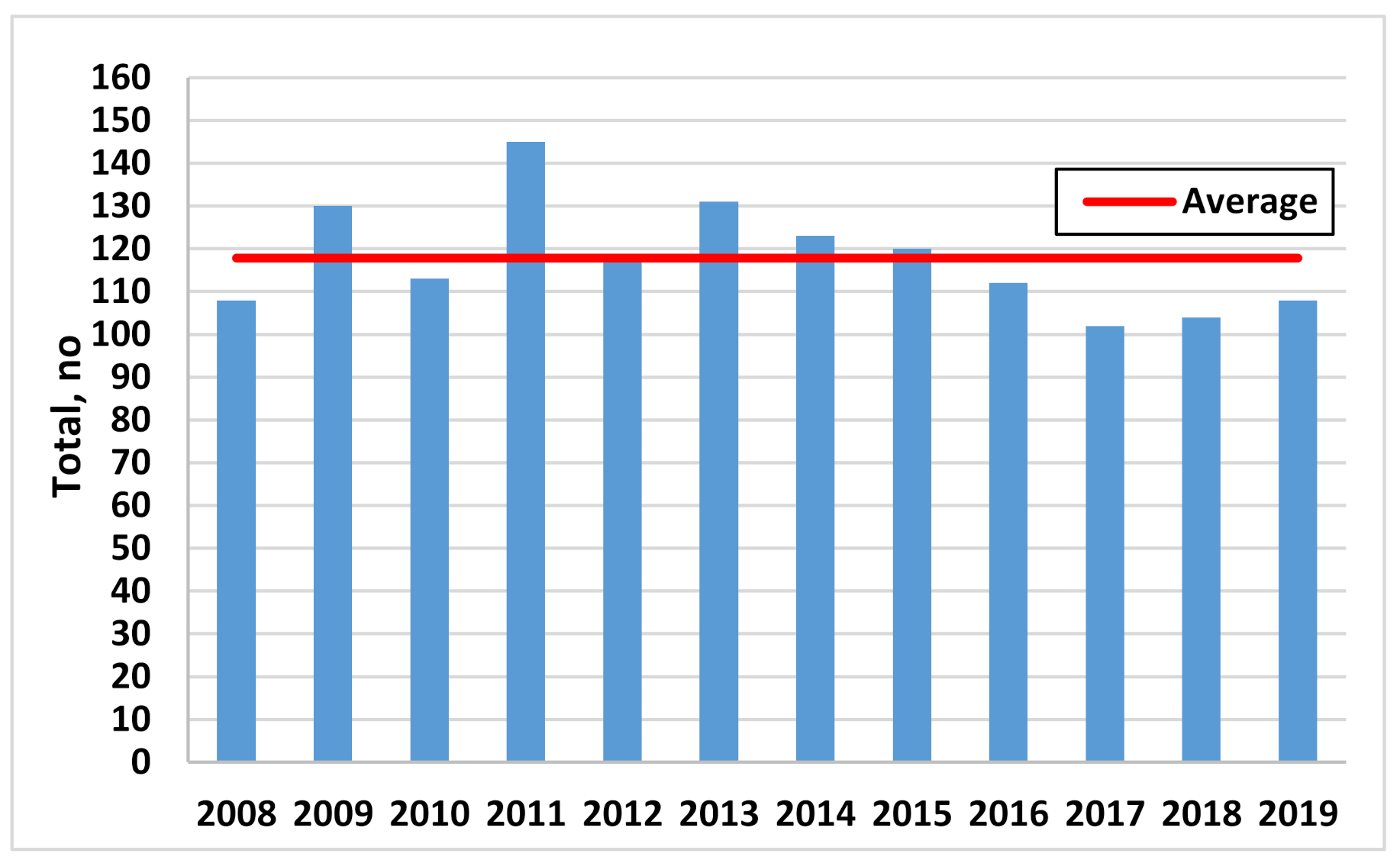
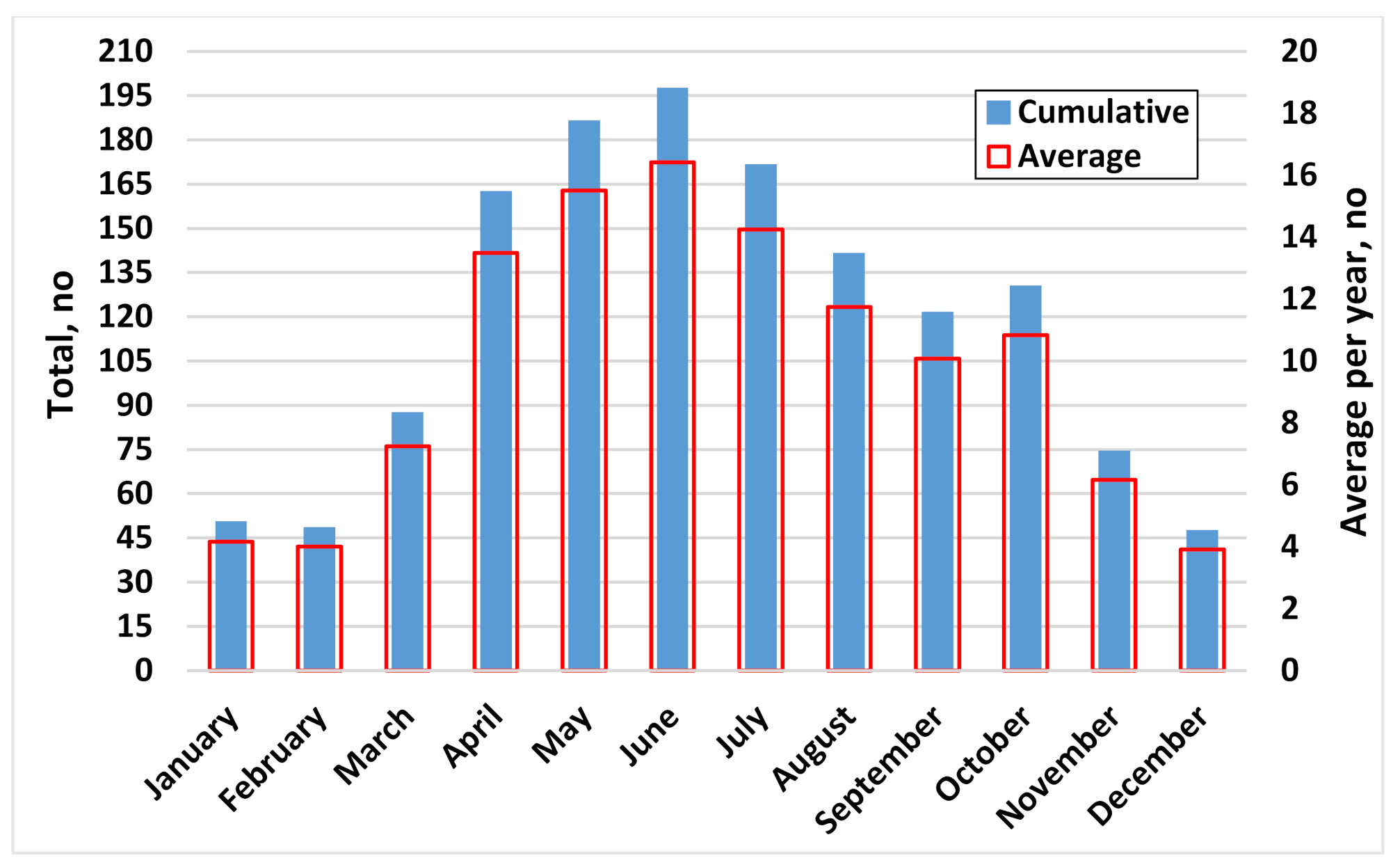
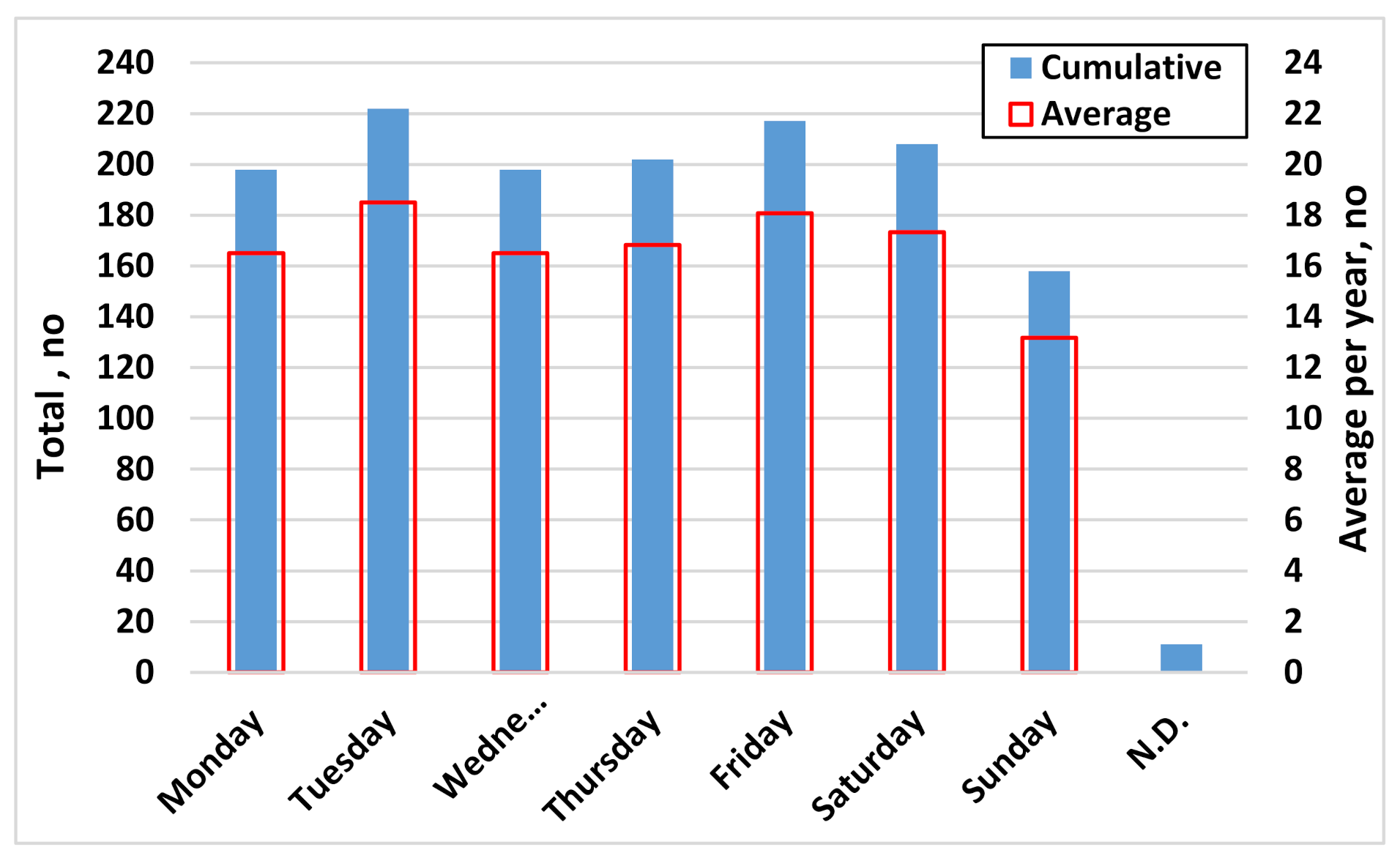
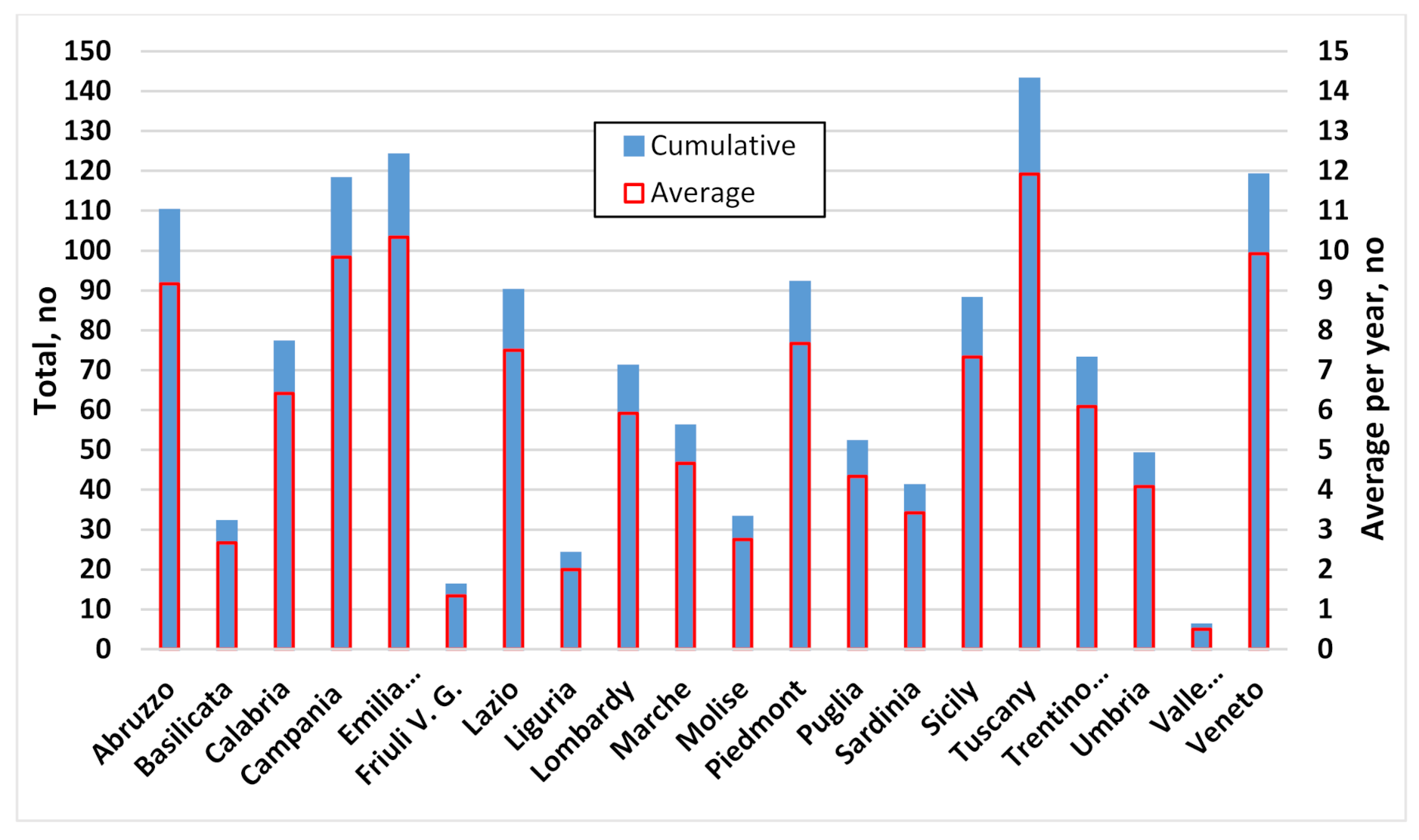
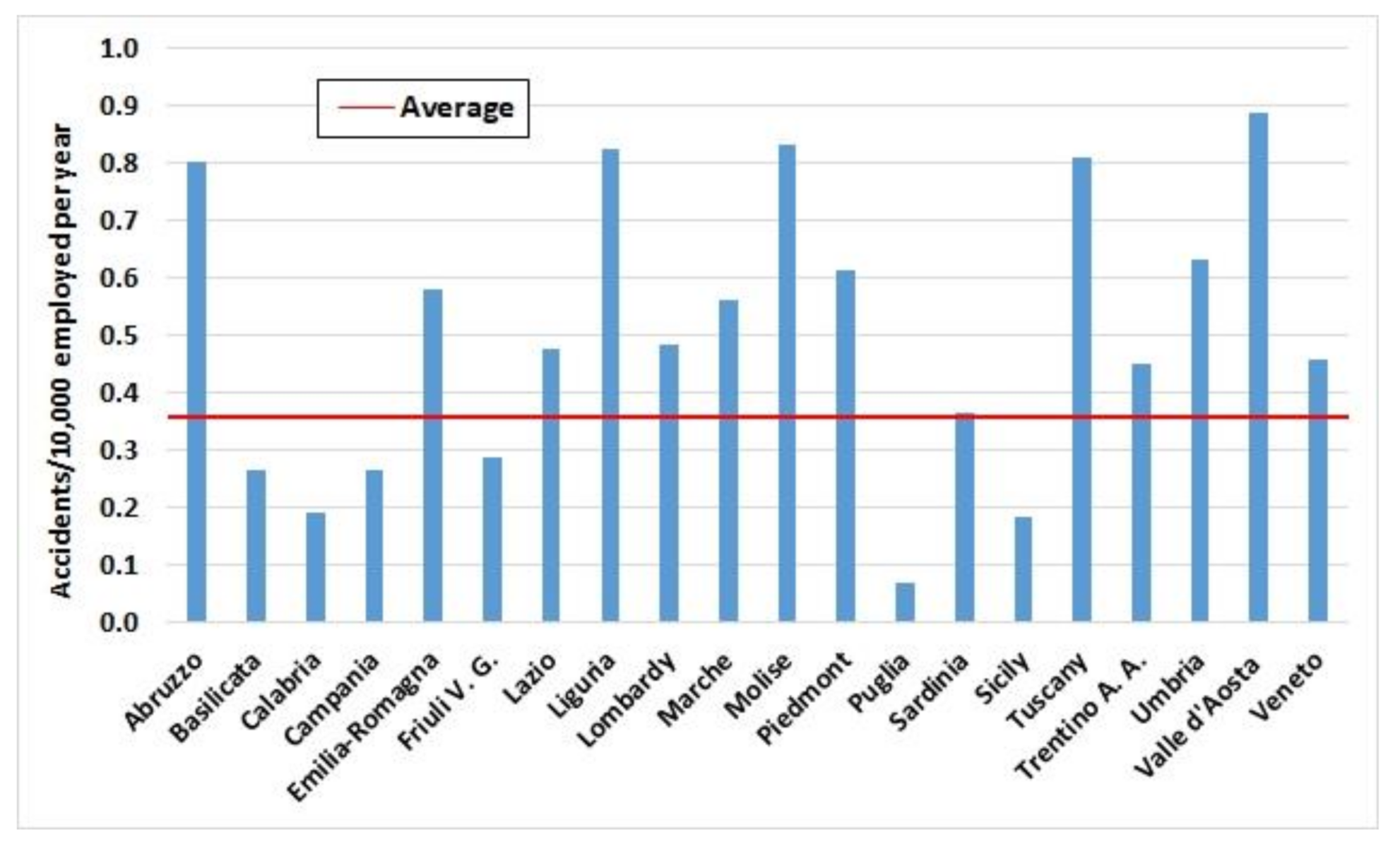

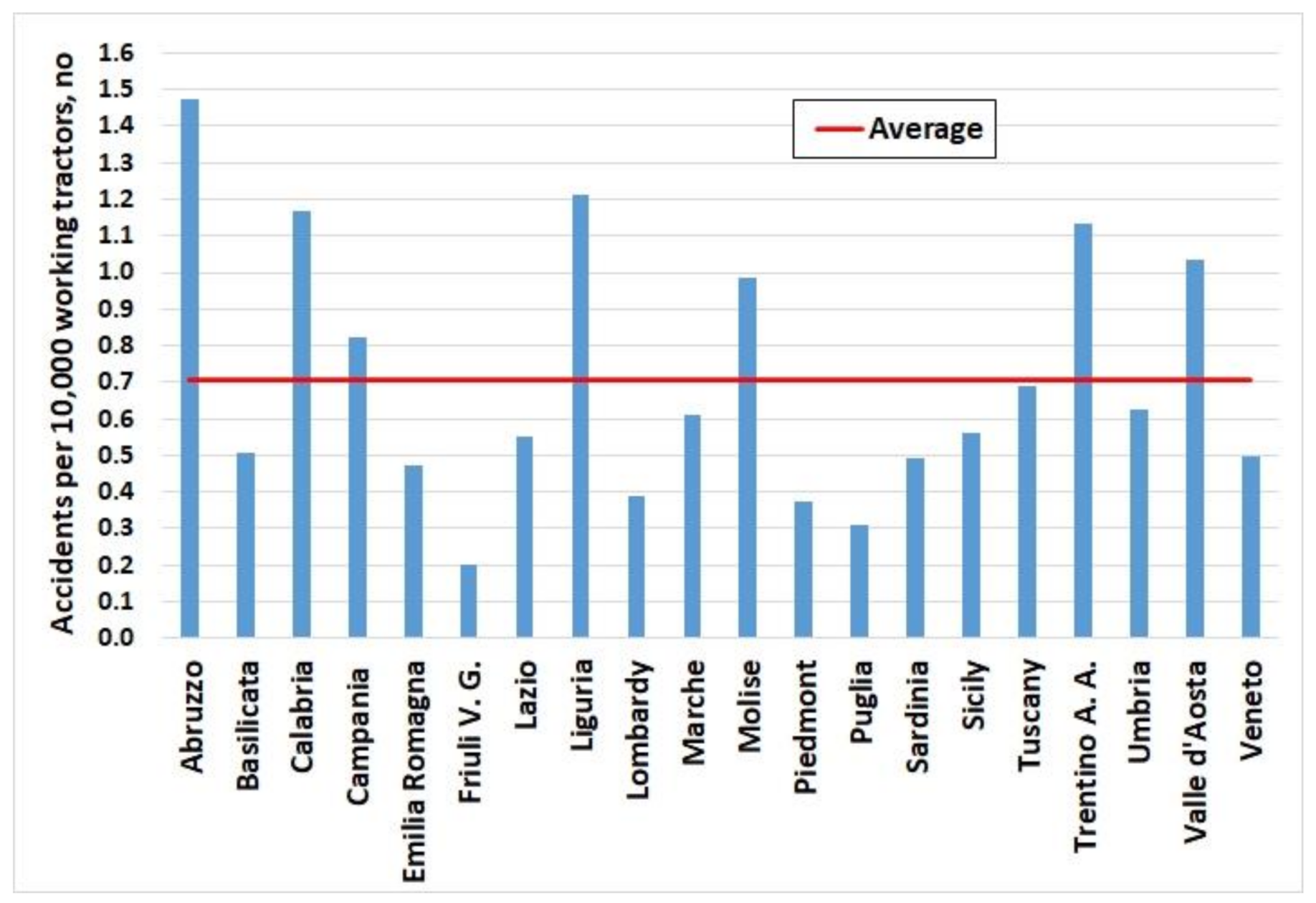
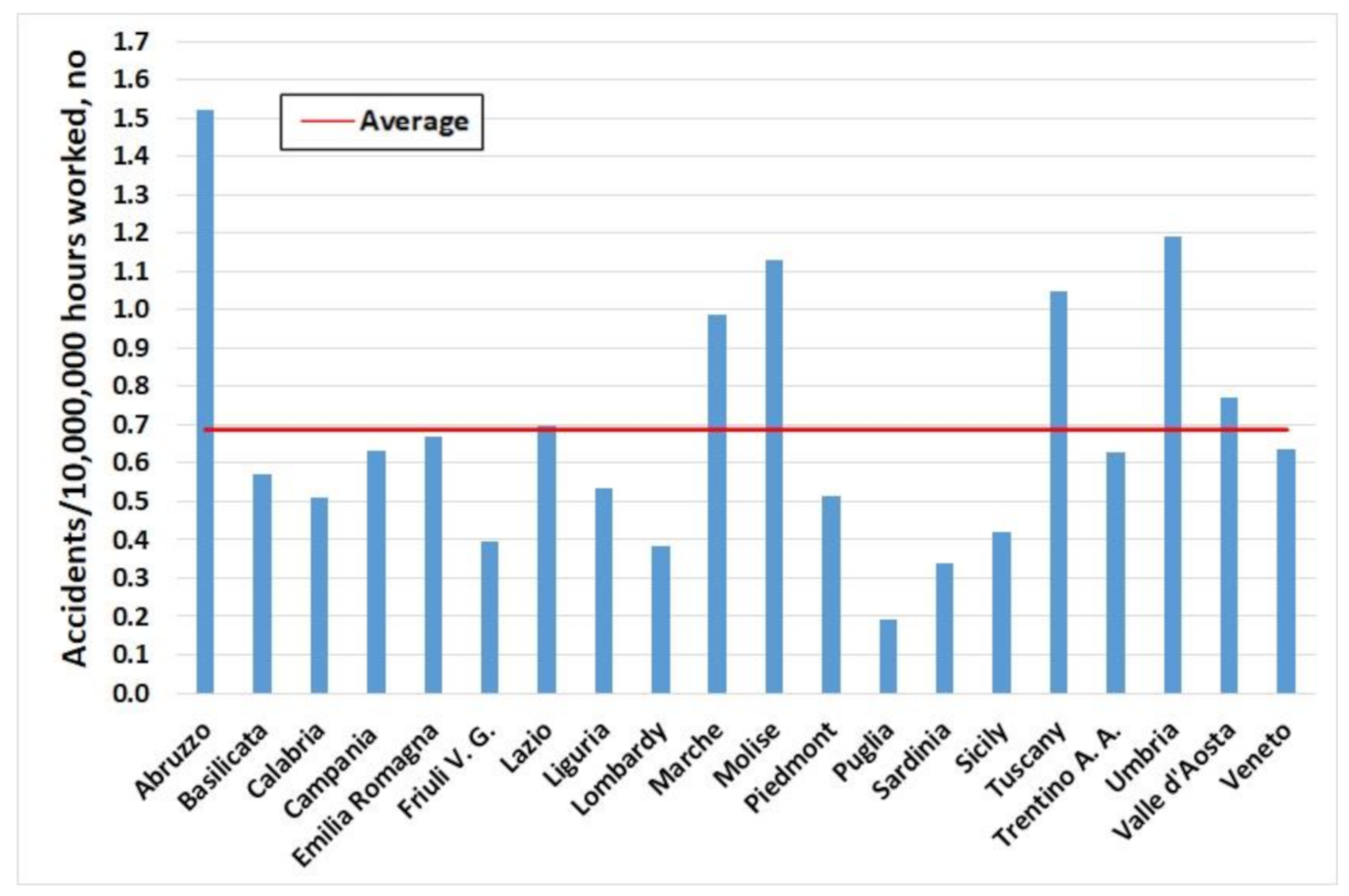
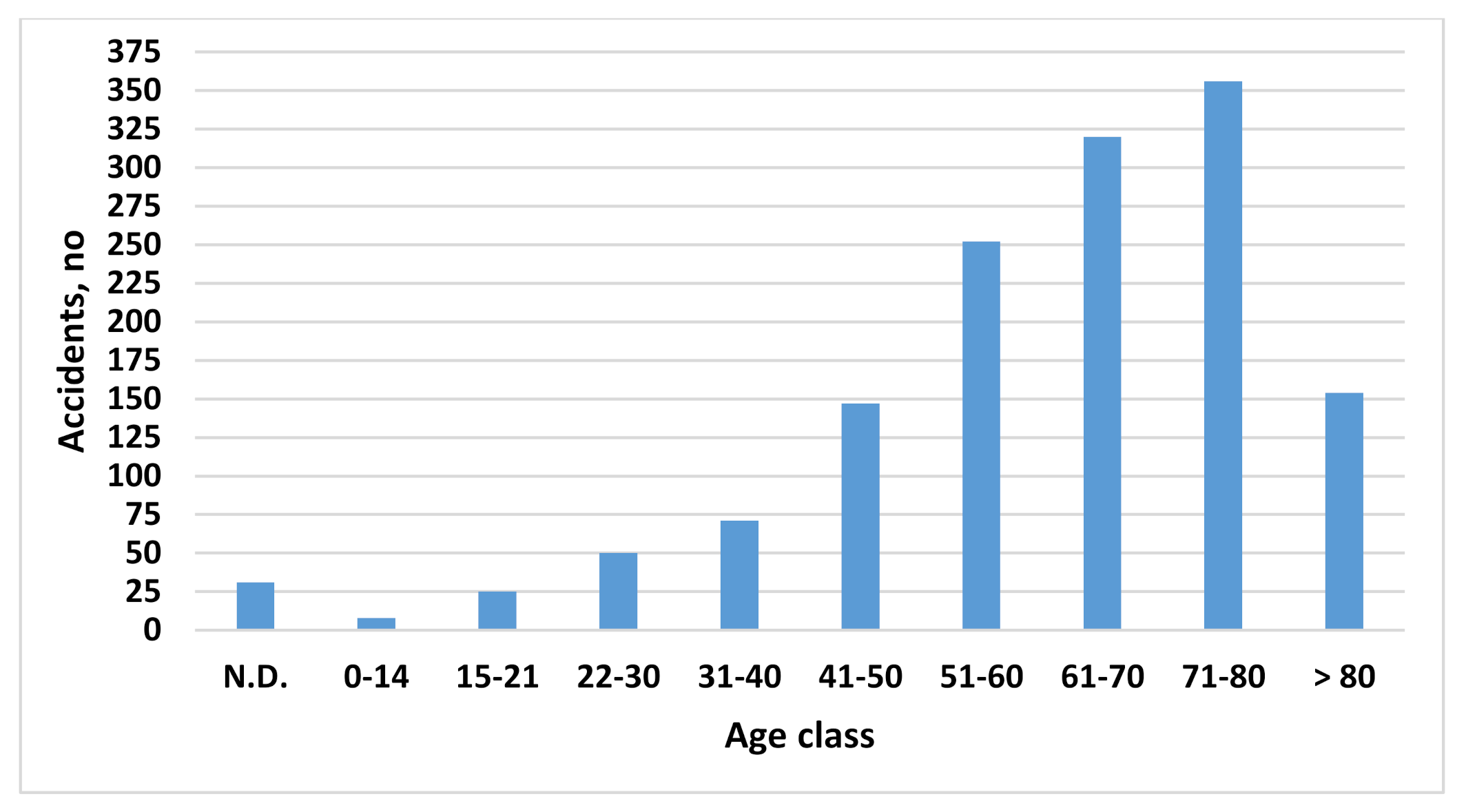

| Data | Detail |
|---|---|
| Date | Year, month, and day |
| Site | Region, province, and municipality |
| Driver | Gender, age, and nationality |
| Passenger | Number |
| Activity | Field task and road transfer |
| Tractor characteristics | Wheeled and crawler |
| ROPS type | Cab, 4-pillar frame, 2-pillar frame, etc. |
Publisher’s Note: MDPI stays neutral with regard to jurisdictional claims in published maps and institutional affiliations. |
© 2021 by the authors. Licensee MDPI, Basel, Switzerland. This article is an open access article distributed under the terms and conditions of the Creative Commons Attribution (CC BY) license (https://creativecommons.org/licenses/by/4.0/).
Share and Cite
Facchinetti, D.; Santoro, S.; Galli, L.E.; Pessina, D. Agricultural Tractor Roll-Over Related Fatalities in Italy: Results from a 12 Years Analysis. Sustainability 2021, 13, 4536. https://doi.org/10.3390/su13084536
Facchinetti D, Santoro S, Galli LE, Pessina D. Agricultural Tractor Roll-Over Related Fatalities in Italy: Results from a 12 Years Analysis. Sustainability. 2021; 13(8):4536. https://doi.org/10.3390/su13084536
Chicago/Turabian StyleFacchinetti, Davide, Stefano Santoro, Lavinia Eleonora Galli, and Domenico Pessina. 2021. "Agricultural Tractor Roll-Over Related Fatalities in Italy: Results from a 12 Years Analysis" Sustainability 13, no. 8: 4536. https://doi.org/10.3390/su13084536
APA StyleFacchinetti, D., Santoro, S., Galli, L. E., & Pessina, D. (2021). Agricultural Tractor Roll-Over Related Fatalities in Italy: Results from a 12 Years Analysis. Sustainability, 13(8), 4536. https://doi.org/10.3390/su13084536







